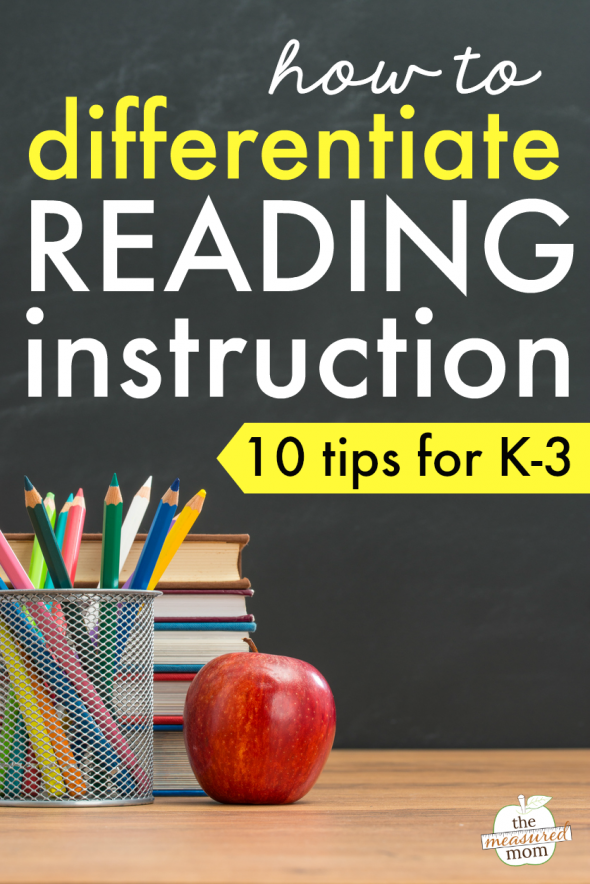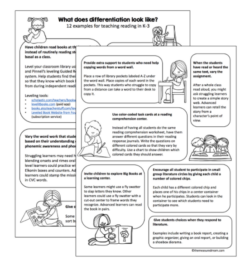10 tips for differentiated reading instruction in K-3
This postal service contains affiliate links. As an Amazon Associate I earn from qualifying purchases.
Looking for tips to attain differentiated reading instruction in M-3? You're in the correct identify!

(This mail service contains chapter links.)
Differentiation.
It'southward the big buzz discussion these days, isn't information technology?
But what does it really mean?
Merely put, differentiation is tailoring your didactics to meet the needs of individual learners.
Co-ordinate to Carol Ann Tomlinson, "Differentiating instruction means 'shaking up' what goes on in the classroom so that students take multiple options for taking in information, making sense of ideas, and expressing what they acquire."
Differentiation is not …
- giving the aforementioned instruction and assignments to the entire class, day after day.
- giving busy work or actress issues to early on finishers.
- doing something different for every student in your classroom. (Whew!)
Differentiation is …
- a flexible approach to instruction.
- adjusting how we teach based on students' readiness levels, interests, and learning styles.
- changing the way we teach then that anybody – the avant-garde, struggling, and on-level readers, Learn.
Here's the thing.
Differentiation isn't easy.
But here's the good news!
Past post-obit a few fundamental tips, you can larn to meet the needs of all your readers.
And you can practice information technology with the time yous have – without burning yourself out.
Let'south take a look at 10 tips for differentiating reading didactics in K-3.
ten tips for differentiating reading Grand-3
ane. Accept the time to teach structure and routines.
Wearisome, correct? I mean, why spend a couple of weeks practicing routines when learning to read is so much more fun?
If you lot've taught for more than a calendar week, you lot know the answer.
If we skip over the routines, information technology'due south just a matter of time before our classrooms go a hot mess. Every time nosotros endeavour to sit down with a small grouping, we'll exist interrupted. There will be mayhem and quarreling at center fourth dimension. Before long we'll want to grab a stack of identical worksheets and throw our differentiation dreams out the window.

We all know that it's important to teach structure and routines. But how do we begin?
The play tricks is to think almost all the moving parts that will brand your reading cake run smoothly. So model what you want to see. And do, practise, practice.
Consider:
- How will students gather for read aloud time?
- How will they motion through learning centers?
- How volition students choose their own books?
- How volition they "assist themselves" when y'all are busy with a pocket-size group?
- What will they do when they terminate their work?
- How will yous minimize noise?
- How will students work productively in modest groups?
two. Organize your classroom library.
I used to recommend leveling much of the classroom library using Fountas & Pinnell's guided reading leveling system.
I no longer recommend this, because after studying the science of reading I no longer support using the early predictable books with beginning readers.
Instead, I recommend building up your collection of quality decodable books and giving them their ain bins.
I likewise recommend sorting books past series and topic.
iii. Appraise regularly, and programme how you'll use the results.
When yous think of cess, what comes to mind? For many of the states, assessment is that thing we practise at the terminate of the unit to meet if our students "got information technology." Simply that'southward only one way to assess – and considering it'southward after the education has ended, it'southward not even the most effective!
Consider all the means to get together data well-nigh your learners!
- conversations with students
- classroom discussions
- student work
- observation
- formal assessments
Whether you're referring to the results of formal instruction such as DIBELS or informal notes that you jot downwards during guided reading time – you've got to decide what to do with the information.
I advise recording the data on a spreadsheet. Utilise the nautical chart to grouping students with similar needs. Then make plans for how to address their needs in small groups or in private reading conferences.
iv. Structure your reading block for differentiation.
If your reading instruction is typically a cake of whole course pedagogy, it'southward difficult to differentiate.
I recommend starting the reading block with whole-class phonemic sensation and phonics instruction.
Then dissever your students into needs-based groups so yous can become deeper on basic skills (such as phonics and spelling) or focus on fluency and/or comprehension.

A smart manner to conclude your reading time is with an interactive read-aloud.
five. Rethink independent reading time.
Back when I was a student (ahem) years ago, silent reading time was about promoting the enjoyment of reading. In hopes of achieving that, teachers made sure that every child was occupied with a book. It could exist Whatsoever book, equally long as it was made of paper and had words in it. The teacher read at the same time (or graded papers).

Times accept changed. While nosotros certainly want our students to larn to enjoy reading, our goals for independent reading time are bigger than that. It'due south a teaching time.
I recommend giving each child a bag of books with books due south/he is responsible for reading. For nearly early readers, these should be decodable books that feature phonics patterns you lot've already taught.
You might also include pocket-size versions of text you lot've read together during shared reading.
Finally, consider assuasive kids to have "dessert books" that they enjoy looking at but cannot read yet. (Insist, however, that they practise their decodable books first.)
6. Don't exist agape of explicit instruction.
For years I've been a balanced literacy advocate, only every bit I learn more about the scientific discipline of reading I'thou experiencing a shift in my thinking.
I used to be agape of explicit instruction … to me information technology could only hateful wearisome-snoring drill and kill.
Only when yous have a strong reading curriculum with hands-on materials, explicit teaching can exist pleasant and – yeah- even fun.
7. Employ flexible grouping.
The reality is that you probably accept your low, medium, and high readers. And there volition be many times that it will brand sense to group them accordingly. But not e'er.
Whatever you do, don't create labeled, permanent groups that never change.
eight. Give kids meaningful work, not busy work.
Your explicit, whole grade lessons are important. Your explicit, small group instruction is of import.
But your centers are important, as well.
It's tempting to create beautiful eye activities without stopping to consider our goals and objectives. We might want to go along the kids busy and so we can focus on the "important" learning in our modest groups.
Rather than make the learning centers cute, isolated activities, utilise them as an extension of whole and small group instruction.
It's okay if they're still cute. 😉
9. Make the work for all learners as appealing.
This is a biggie. Don't requite your low learners worksheets while the advanced learners get to play a game. Your goal should exist to emphasize disquisitional thinking in every lesson. You won't always accomplish this, and that's okay. Simply we need to be careful non to take struggling readers do depression level tasks while the avant-garde learners practice all the hard thinking.
10. Take information technology slow, and be easy on yourself.
During my first years of education I took one subject to improve on each year. I spent all summer reading, studying, and planning for how I was going to take my teaching to the adjacent level.
You can have the same approach to differentiation.
Keep calculation new strategies to your toolbox with each succeeding twelvemonth.
All these tips are nifty, but…
What does differentiation Expect like?
If you lot're on the lookout for practical, real-globe ways to differentiate, I've got you covered. Download my gratuitous cheatsheet beneath – with specific examples you can try correct in your classroom!

Get your free cheat sheet!
How to build reading comprehension
Detect the essential reading comprehension strategies for 2d & 3rd grade and how to teach them!

masseywortatuslege.blogspot.com
Source: https://www.themeasuredmom.com/differentiated-reading-instruction-tips/
0 Response to "10 tips for differentiated reading instruction in K-3"
Publicar un comentario